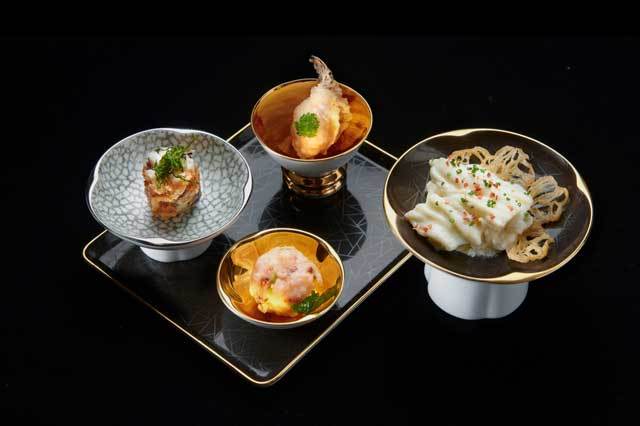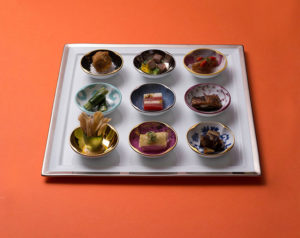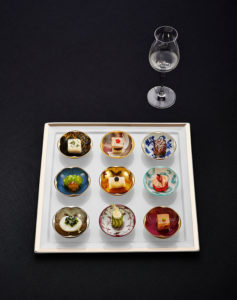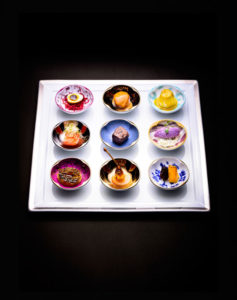

Wing Lei Palace, Wynn Cotai / Macao China
Extraordinary Cantonese cuisine takes centre stage at Wing Lei Palace. This 2-Michelin star fine dining restaurant, is helmed by Executive Chef Tam Kwok Fung, a Gold Medalist and World Champion of Chinese Cooking.
Throughout his illustrious career, Chef Tam has cooked for dignitaries, politicians and royal families.
His innovative culinary creations centre round his philosophy: food should be healthy, natural and in harmony with the seasons, while preserving the rich traditions of Cantonese cuisine.
Braised Giant Grouper Skin, Pomelo Peel, Kombu and Venison Tendon
This dish was inspired by the Manchu Han Imperial Feast, named Kunlun Bao Fu that used an exceptionally precious ingredient – the skin of a giant grouper.
Ensuring the skin’s perfect texture and flavor required meticulous cooking. Its taste was perfectly complemented by abalone sauce, which made it a favorite dish of dignitaries at imperial feasts.
Chef Tam has chosen a modern cooking method to present this vintage flavor, complementing the giant grouper skin with venison tendon, kombu and pomelo peel.
This collagen-rich dish uses ingredients from the land and sea, and is braised with various sauces, including chicken, beef, dried flatfish and shrimp as well as abalone respectively, for a variety of combinations of flavors.
Lamb Cheek and Shank Soup with Tossed Hoi-Fu Shark’s Fin
This popular dish from the ’60s and ’70s is steeped in Cantonese culture, using precious collagen-rich and tonic ingredients. However, it fell out of use because of its lengthy and complex preparation, which made it difficult to pass down across generations.
Chef Tam’s reinterpretation preserves the essence of this dish with the head and shank of lamb with delicate lamb skin. The meat is slow-cooked for hours with white pepper and galanga, then sliced into similar-sized pieces and served with lamb neck meat to enhance the soup’s smoothness and texture.
The hoi-fu shark’s fin is cooked as a broth, and it can be enjoyed separately or together with the soup. Lost flavors are precious. So, too, are the cultural and artistic techniques of the past, like the mini tureen inspired by Kyoto style lacquer and Song style crack glaze, using red and black as its primary color, which was once believed lost and then rediscovered.
Modern gold lines here imitate cracks in the style of the Longquan celadon. Meanwhile, the shark’s fin soup is presented with a lotus tea cup in “Tian-mu” black glaze and hand painted gold guiding, offering a touch of Zen and an ode to Buddhism.
Golden-fried Lace Fat Rolls and Scrambled Egg White with Buffalo Milk Cheese
This dish is based on the traditional Cantonese caul fat roll. Originally, this dish was made with pork kidney and pork liver, which were wrapped in caul fat and then deep-fried.
Due to the handling process of lace fat is very complicated, the dish started to fade out. Chef Tam’s reinterpretation of this classic dish by rolling the healthy seasonal ingredients featuring Toyama white shrimp, French blue lobster and crab claw with lace fat which brings up multiple delicious layers of texture and the rich aroma of caul fat.
The creamy fried milk that accompanies the rolls elevates the flavors even further. Traditional wisdom should be preserved for future generations, just like the design of this historic high footed plates.
Designs for long-stemmed high footed plates were used in China as far back as 6,000 years ago, from Neolithic ceramic wares to the bronze wares of the Xia, Shang and Zhou dynasties. The Han, Wei and Jin dynasties also used this style of high footed plates for their lacquerware wines, and the Tang Dynasty featured similar pottery and chinaware.
These Tang style high footed plates in modern composition are perfect for preserving China’s disappearing flavors as well as the culinary art of the caul fat roll and fried buffalo milk cheese.
YOU MIGHT ALSO LIKE











